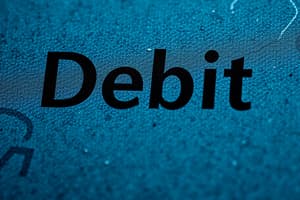Podcast
Questions and Answers
Match the following with their descriptions:
Match the following with their descriptions:
Credit and collections policy = Clear, written guidelines for supplying goods on credit and managing collections Credit policy = Guidelines and processes for executing corporate credit strategy Credit risk analysis = Assesses the effectiveness of a company’s credit policy and balances various interests Loan characteristics = The specifics of how an organization advances credit and lends to others
Match the following with their goals:
Match the following with their goals:
Credit and collections policy = Optimizing resources, reducing credit risk, and improving overall cash flow Credit policy = Ensuring new business aligns with credit risk tolerance and effectively collecting debts Credit risk analysis = Balancing various interests to achieve corporate credit strategy goals Loan characteristics = Assessing the effectiveness of a company’s policy and balancing various interests
Match the following with their focus areas:
Match the following with their focus areas:
Credit and collections policy = Customer qualification criteria and delinquency procedures Credit policy = Processes for executing corporate credit strategy Credit risk analysis = Assessing the effectiveness of a company’s policy Loan characteristics = Advancing credit and lending to others
Match the following with their functions:
Match the following with their functions:
Match the following with their definitions:
Match the following with their definitions:
Match the type of credit policy with its description:
Match the type of credit policy with its description:
Match the components of a credit policy with their descriptions:
Match the components of a credit policy with their descriptions:
Match the examples with the type of credit policy they represent:
Match the examples with the type of credit policy they represent:
Match the organization's specific needs with the type of policies mentioned in the text:
Match the organization's specific needs with the type of policies mentioned in the text:
Match the ABA report on credit conditions with its purpose:
Match the ABA report on credit conditions with its purpose:
Flexible credit represents a neutral strategy that does not aggressively grow or restrict access to credit for clients.
Flexible credit represents a neutral strategy that does not aggressively grow or restrict access to credit for clients.
Tight credit strategy is often implemented to limit credit losses and/or replenish capital.
Tight credit strategy is often implemented to limit credit losses and/or replenish capital.
Loose credit policy represents an unwillingness to extend credit, as a company is highly risk-averse or has no business case to support the cost/benefit of extending credit.
Loose credit policy represents an unwillingness to extend credit, as a company is highly risk-averse or has no business case to support the cost/benefit of extending credit.
The ABA report on credit conditions measures the general type of credit policy for small businesses.
The ABA report on credit conditions measures the general type of credit policy for small businesses.
Components of a sound credit policy include the credit application process, types, limits and terms of credit, collection, monitoring and control, and risk management.
Components of a sound credit policy include the credit application process, types, limits and terms of credit, collection, monitoring and control, and risk management.
A credit and collections policy outlines guidelines for customer qualification, but does not provide steps for making collections.
A credit and collections policy outlines guidelines for customer qualification, but does not provide steps for making collections.
The main goal of a credit collections plan is to increase credit risk and reduce overall cash flow.
The main goal of a credit collections plan is to increase credit risk and reduce overall cash flow.
Credit risk analysis only considers sales goals and customer demand, neglecting other factors.
Credit risk analysis only considers sales goals and customer demand, neglecting other factors.
A credit policy serves as a comprehensive guide and processes for executing a corporate credit strategy.
A credit policy serves as a comprehensive guide and processes for executing a corporate credit strategy.
An organization that advances credit should not be concerned with aligning new business with its credit risk tolerance.
An organization that advances credit should not be concerned with aligning new business with its credit risk tolerance.
Flashcards are hidden until you start studying
Study Notes
Credit Policy Strategies
- Flexible credit policy: Neutral strategy that neither aggressively grows nor restricts access to credit for clients.
- Tight credit strategy: Implemented to limit credit losses and/or replenish capital.
- Loose credit policy: Unwillingness to extend credit due to high risk aversion or lack of business case to support the cost/benefit of extending credit.
Components of a Sound Credit Policy
- Credit application process
- Types, limits, and terms of credit
- Collection
- Monitoring and control
- Risk management
Credit Risk Analysis
- Considers multiple factors, not just sales goals and customer demand
Credit Policy Purpose
- Comprehensive guide and processes for executing a corporate credit strategy
Credit and Collections Policy
- Outlines guidelines for customer qualification
- Does not provide steps for making collections
Credit Collections Plan Goal
- Reduce credit risk and increase cash flow (opposite of stated goal)
Organization and Credit Risk Tolerance
- Organization that advances credit should align new business with its credit risk tolerance
Studying That Suits You
Use AI to generate personalized quizzes and flashcards to suit your learning preferences.




